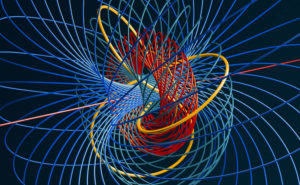The following is essentially the content of the second talk I gave on Sasakian and Kähler manifolds.
Sasakian Boothby-Wang Fibrations
Theorem (Newlander-Nirenberg)
An almost complex structure \(J\) is integrable if and only if the Nijenhuis tensor
\[N_J(X,Y) = -J^2[X,Y] + J([JX,Y] + [X,JY]) – [JX,JY]\]
vanishes.
The Boothby-Wang fibration gives a canonical circle bundle over a symplectic manifold. Recall, of course, that Kähler manifolds are symplectic; there is the following interesting result:
Theorem (Hatakeyama)
Suppose that on a principle fiber bundle \(\pi \colon \mathbb{M} \rightarrow \mathbb{B}\) over an almost complex manifold \(\mathbb{B}\) with group \(S^1\) we can define an almost contact structure \((\xi,\eta,\Phi)\). Then if the almost complex structure \(J = \Phi \vert_\mathbb{B}\) is integrable and the curvature form \(\omega\) given by \(\pi^*\omega = d\eta\) on \(\mathbb{B}\) associated to the contact form \(\eta\) of \(\mathbb{M}\) is of type \((1,1)\) with respect to the almost complex structure, then the almost contact structure on \(\mathbb{M}\) is normal.
Proof:
By a paper of Sasaki and Hatakeyama normality of the contact metric structure is equivalent to the vanishing of the tensor
\[N(X,Y) = [X,Y] + \Phi [\Phi X,Y] + \Phi [X,\Phi Y] – [\Phi X,\Phi Y] – \eta([X,Y])\xi – d\eta(X,Y)\xi\]
which follows from considering the Nijenhuis tensor on the Riemannian cone over \(\mathbb{M}\). Projecting onto the horizontal and vertical spaces, it is clear that \(N(X,Y) = 0\) if and only if \(\pi(N(X,Y)) = 0\) and \(\eta(N(X,Y)) = 0\). Directly, it can be seen that
\[\pi(N_p(X,Y)) = \bar{N}_{\pi(p)}(\pi X,\pi Y)\]
where \(\bar{N}\) is the Nijenhuis tensor associated to the almost complex structure \(J\) on \(\mathbb{B}\). Then the Newlander-Nirenberg theorem implies that \(N\) will vanish only if \(J\) is integrable.
Moreover,
\[\eta(N(X,Y)) = -\eta([\Phi X,\Phi Y]) – d\eta(X,Y)\]
and
\[-\eta([\Phi X,\Phi Y]) = d\eta(\Phi X,\Phi Y)\]
so that \(\eta(N(X,Y))\) vanishes if any only if
\[d\eta(\Phi X,\Phi Y) = d\eta(X,Y)\]
which is equivalent to
\[\omega(J(\pi X), J(\pi Y)) = \omega( \pi X, \pi Y)\]
and so we are done.
Taking the last two results together gives
Theorem (Hatakeyama)
A necessary and sufficient condition for a compact manifold with a regular contact structure to admit an associated normal contact metric structure (and thus be Sasakian) is that the base manifold of the Boothby-Wang fibration of \(\mathbb{M}\) is Hodge.
Proof:
One direction is the content of the Boothby-Wang theorem. If \(\mathbb{M}\) is Hodge, it is Kähler, and thus the almost complex structure is integrable. From the first talk, the almost complex structure is compatible with the symplectic form \(\omega\), which is precisely the statement
\[\omega(JX,JY) = \omega(X,Y)\]
and so we are done.
3-Sasakian manifolds
We want to introduce a generalization of the Kähler-Sasakian correspondence by allowing for the existence of triples of structures obeying a quaternionic relation. We begin with the following
Definition:
Let \(\mathbb{M}\) be a \(4n\)-dimensional manifold with 3 integrable almost complex structures \(I_1,I_2,I_3\) such that
\[I_iI_j = -\delta_{ij}Id + 2 \epsilon_{ijk}I_k\]
Then we call \((\mathbb{M}, I,J,K)\) a hyperkähler manifold.
To develop the corresponding `Sasakian’ notion, we begin with extending the definition of a `contact’ manifold.
Definition:
Let \(\mathbb{M}\) be a \(4n+3\)-dimensional manifold such that there exists a family of contact structures \(\mathcal{S} = \{\eta(\tau),\xi(\tau),\Phi(\tau)\}\) parameterized by \(\tau \in S^2\) satisfying the relations
- \(\Phi(\tau) \circ \Phi(\tau’) – \eta(\tau) \otimes \eta(\tau’) = – \Phi(\tau \times \tau’) – (\tau \cdot \tau’)Id\)
- \(\Phi(\tau)\xi(\tau’) = – \xi(\tau \times \tau’)\), and
- \(\eta(\tau) \circ \Phi(\tau’) = – \eta(\tau \times \tau’) \)
for all \(\tau, \tau’ \in S^2\). We then call \((\mathbb{M}, \{\eta(\tau),\xi(\tau),\Phi(\tau)\})\) an almost hypercontact manifold. If moreover there exists a Riemannian metric \(g\) on \(M\) such that
\[g(\Phi(\tau)X, \Phi(\tau)Y) = g(X,Y) – \eta(\tau)(X) \eta(\tau)(Y)\]
for all \(\tau \in S^2\) we call \((\mathbb{M}, g, \{\eta(\tau),\xi(\tau),\Phi(\tau)\})\) an almost hypercontact metric manifold.
Remark: Another standard definition comes from a choice of an orthonormal frame on \(\mathbb{R}^3\), which we will refer to as an almost contact (metric) 3-structure.
Remark: Every compact, orientable 3-manifold admits an almost contact 3-structure.
Attempting to generalize the idea of Sasakian manifolds gives us the following
Proposition:
There exists a one-to-one correspondence between almost hypercontact structures on \(\mathbb{M}\) and \(\Psi\)-invariant almost hypercomplex structures \(\mathcal{I}\) on the cone \(C(\mathbb{M}) = \mathbb{M} \times \mathbb{R}^+\).
and so we define
Definition:
Let \((\mathbb{M},\mathcal{S}, g)\) be an almost hypercontact metric manifold. Then if \((C(\mathbb{M}), \mathcal{I}, g)\) is hyperkähler, we call \((\mathbb{M},\mathcal{S}, g)\) 3-Sasakian.
Proposition:
If \(\mathcal{S} = \{\eta(\tau),\xi(\tau),\Phi(\tau)\}\) is a 3-Sasakian structure on \((\mathbb{M},g)\) then
- \(g(\xi(\tau),\xi(\tau’)) = \tau \cdot \tau’\)
- \([\xi(\tau),\xi(\tau’)] = 2\xi(\tau \times \tau’)\)
- \(\Phi(\tau) = -\nabla\xi(\tau)\)
Conversely, if \(\mathcal{S}_1,\mathcal{S}_2, \mathcal{S}_3\) are Sasakian structures on \((\mathbb{M},g)\) with Reeb fields \(\xi_1, \xi_2, \xi_3\) such that
- \(g(\xi_a,\xi_b) = \delta_{ab}\)
- \([\xi_a,\xi_b] = 2\epsilon_{abc}\xi_c\)
then \(\mathcal{S} = \{\mathcal{S}_1,\mathcal{S}_2, \mathcal{S}_3\}\) is a 3-Sasakian structure on \(\mathbb{M}\).
Tags: Boothby-Wang Fibration, Contact Manifolds, Expository, Kahler Manifolds, Sasakian Manifolds

No comments
Comments feed for this article
Trackback link: http://vega-molino.com/2018/06/12/sasakian-and-kahler-manifolds-2/trackback/